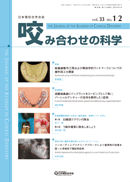Volume 33, Issue 1-2
Displaying 1-14 of 14 articles from this issue
- |<
- <
- 1
- >
- >|
original article
-
Article type: original article
2013 Volume 33 Issue 1-2 Pages 17-22
Published: April 25, 2013
Released on J-STAGE: November 14, 2014
Download PDF (16K) -
Article type: original article
2013 Volume 33 Issue 1-2 Pages 23-30
Published: April 25, 2013
Released on J-STAGE: November 14, 2014
Download PDF (1653K)
clinical report
-
Article type: clinical reports
2013 Volume 33 Issue 1-2 Pages 31-40
Published: April 25, 2013
Released on J-STAGE: November 14, 2014
Download PDF (1644K) -
Article type: clinical reports
2013 Volume 33 Issue 1-2 Pages 41-52
Published: April 25, 2013
Released on J-STAGE: November 14, 2014
Download PDF (2258K) -
Article type: clinical reports
2013 Volume 33 Issue 1-2 Pages 53-64
Published: April 25, 2013
Released on J-STAGE: November 14, 2014
Download PDF (16K) -
Article type: clinical reports
2013 Volume 33 Issue 1-2 Pages 65-74
Published: April 25, 2013
Released on J-STAGE: November 14, 2014
Download PDF (2037K) -
Article type: clinical reports
2013 Volume 33 Issue 1-2 Pages 75-84
Published: April 25, 2013
Released on J-STAGE: November 14, 2014
Download PDF (2166K) -
Article type: clinical reports
2013 Volume 33 Issue 1-2 Pages 85-94
Published: April 25, 2013
Released on J-STAGE: November 14, 2014
Download PDF (1186K)
-
2013 Volume 33 Issue 1-2 Pages 95-98
Published: April 25, 2013
Released on J-STAGE: November 14, 2014
Download PDF (487K) -
2013 Volume 33 Issue 1-2 Pages 99-111
Published: April 25, 2013
Released on J-STAGE: November 14, 2014
Download PDF (16K) -
2013 Volume 33 Issue 1-2 Pages 112-113
Published: April 25, 2013
Released on J-STAGE: November 14, 2014
Download PDF (386K) -
2013 Volume 33 Issue 1-2 Pages 114-115
Published: April 25, 2013
Released on J-STAGE: November 14, 2014
Download PDF (448K) -
2013 Volume 33 Issue 1-2 Pages 118-129
Published: April 25, 2013
Released on J-STAGE: November 14, 2014
Download PDF (1420K) -
2013 Volume 33 Issue 1-2 Pages 130-145
Published: April 25, 2013
Released on J-STAGE: November 14, 2014
Download PDF (1256K)
- |<
- <
- 1
- >
- >|
